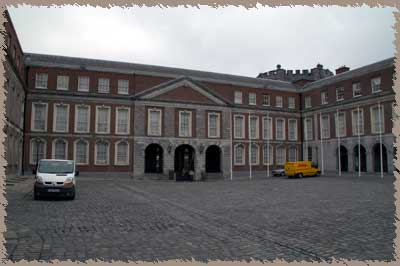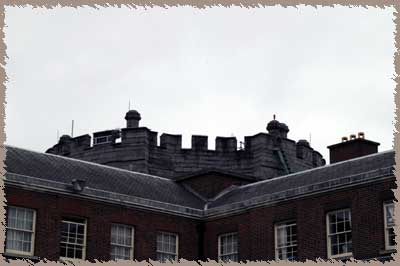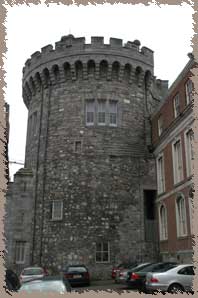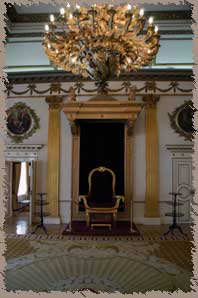
Dublin Castle
Guided tour only€4.50
Mon-Fri 1000-1645
Sat-Su 1400-1645
Photos
neolithic sites
abbeys and churches
castles
dublin
waterford
round towers
lovely scenics
Links
travelogueDublin Castle Homepage
Wikipedia
DublinTourist
Trip Advisor
An absolutely fabulous (and very comprehensive) history of Dublin and Dublin Castle can be found ont he Dublin Castle homepage.

the courtyard of Dublin Castle
There has undoubtedly been a fortification on the site of Dublin Castle since Dublin was merely a wide spot in the road. At first it would have been a wooden palisade, or perhaps a simple motte -- the later stone castle is a Norman construction, built betwen 1208 and 1220. The stone records tower and the undercroft are original (if a bit modified), and they areperhaps the oldest remaining stone buildings in the city. King John ordered the building of the castle in 1204, and the building was begun by Henry de londes (who also worked on St. Patrick's Cathedral.
 The first stone, Norman castle looks like any other Norman castle -- gray stone, towers, arched entrance, drum towers at the corners. A moat was added on the outer wall. Even during much of the next centuries, the general shape of the castle didn't change much and only in the 18th century did the facade begin to look as it does now. The main courtyard looks very much like te Royal Hospital in Kilmainham -- they were designed by the same architectect, Robinson..
The first stone, Norman castle looks like any other Norman castle -- gray stone, towers, arched entrance, drum towers at the corners. A moat was added on the outer wall. Even during much of the next centuries, the general shape of the castle didn't change much and only in the 18th century did the facade begin to look as it does now. The main courtyard looks very much like te Royal Hospital in Kilmainham -- they were designed by the same architectect, Robinson..

Top of the drum tower, from the courtyard
The only way to see the castle interior is with a guided tour -- ours was fabulous. The young woman giving the tour was obvbiously a theater major, and it was all very dramatic and extremely fun. We toured the state apartments,and also went down into the newly opened 'Undercroft', which opened up some of the oldest foundations of the stone buildings here, and the tiniest trickle of the River Poddle -- the only place it's actually visible. When the foundations were excavated, our guide told us, they found three hundred heads at the base of the wall. Just the heads. The famour pool of Dark Water -- Dubh Linn -- lies under the castle grounds.


the remaining norman tower / the slightly shortened chair in the throne room
The castle looks relatively modern -- the only Norman remains are the single drum tower and the foundations. THe rest of the buildings are standard, government-issue stone facades with an enormous open courtyard in front of the entrance. These are state buildings, and any trace of unique fortification on the outside have been covered by rows of office windows. Well, except for the statue of justice on the roof -- which holds the scales of justice...which just happeened to tip to one side when it rained. They had to drill holes in the pans! It was, some noted, a commentary on British justice.